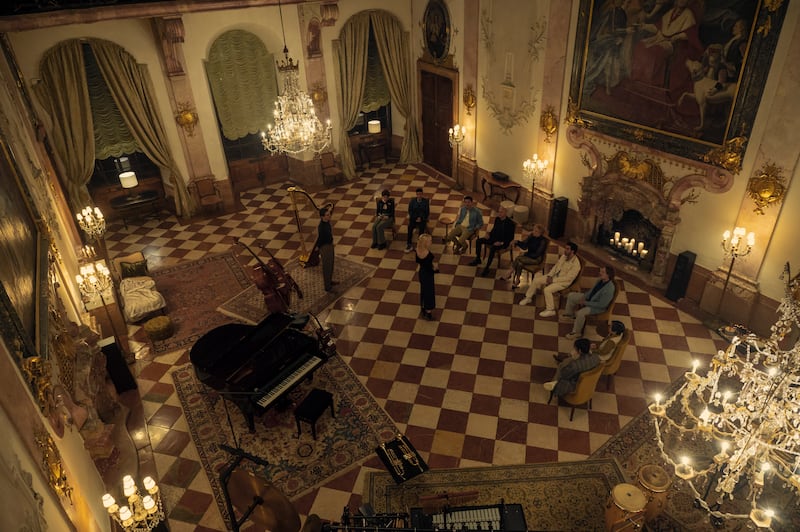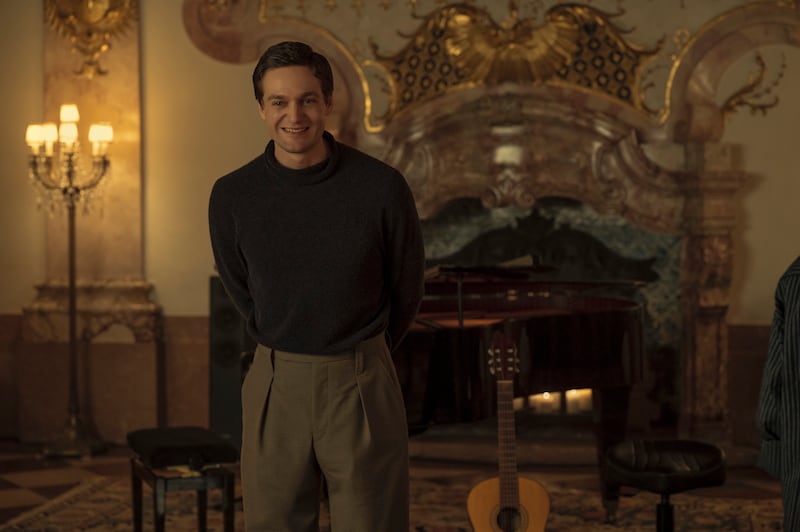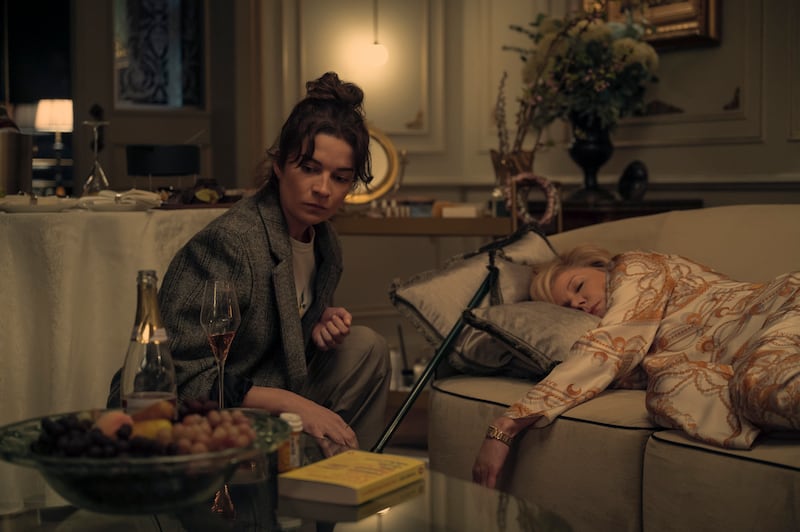(Warning: Spoilers ahead.)
If Nicole Kidman tells you to play, you play.
Or rather, if her Nine Perfect Strangers wellness guru, Masha, delivers an instruction to feel inspired by music, the guests at this exclusive Alpine setting don’t have much wiggle room to say no. Luckily, in this week’s new episode of the series, most of the group is experiencing the effects of a handcrafted dose of psilocybin intended to lower their inhibitions. Soon, they’re dancing like no one is watching.
In the first season of the trippy Hulu drama, Masha spiked the retreat guests with psychedelics without their knowledge. Now, everyone taking part in the experimental therapy is a willing participant. Well, mostly. Former piano-playing prodigy Tina (King Princess) was unaware of the unique activities on offer at Zauberwald and has spent the first few episodes at war with girlfriend Wolfie (Maisie Richardson-Sellers).
Theirs is not the only strained relationship. Estranged mother-daughter Victoria (Christine Baranski) and Imogen (Annie Murphy) have enough resentment to fuel the entire Bavarian property, with Imogen frequently voicing her frustrations. It doesn’t help that Victoria has brought younger lover Matteo (Aras Aydin) as her plus-one to what was meant to be a chance to reconnect with Imogen.
It’s not the only parental-disappointment situation, as Peter (Henry Golding) is doing everything in his power to get his billionaire father, David (Mark Strong), to even notice him. Peter is not alone, as Masha’s assistant Martin (Lucas Englander) tries to impress his mother Helena (Lena Olin) through his work in this therapeutic program. Now is Martin’s time to shine in a sequence that dials up exhibitionism for all.
The Daily Beast’s Obsessed sat down with Baranski, Strong, Golding, Englander, and Richardson-Sellers to talk about breaking out their best over-the-top moves, being a spectator, and having Kidman lead the way.

Masha welcomes the group into the Zauberwald ballroom to let them soak up the history of the space that used to be used by famous musicians. She doesn’t name names, so I think this spiel is probably BS. However, this is not about making world-class music; Masha wants her clients to feel inspired by their surroundings.
Golding says it was a life imitating art situation: “You’ve got to start with the room. We went to a beautiful castle-slash-mansion in Salzburg. It was so decadent. They filled it with the most amazing props—grand pianos, cellos.” Baranski shares that this location has movie musical legend status, as The Sound of Music also filmed at this particular Alpine spot.
While the gilded walls are probably accustomed to more traditional waltzes, the conductor of this unorthodox wellness retreat sets the tone. “There are no wrong notes,” Masha declares before twirling out of the room. She sings the last part of the line, and Golding couldn’t help but take a lesson from Kidman’s delivery. “The amazing thing about watching Nicole in her process—obviously, she’s so talented and experienced—but it’s the variance in each take and performance that she gives,” says Golding. “You never quite know what you’re going to get, but it’s so good every single time.”
Given how at ease Masha is with her body and voice, you might expect her to lead this musically aided group therapy. Instead, the permanently awkward Martin takes over when Masha departs to spy from the rafters. For the “free expression” activity, he plays the infectious “Time to Dance” by The Shoes to get everyone on their feet (side note, Jake Gyllenhaal plays a serial killer in the song’s music video). Martin has never sampled the mind-bending stash, yet his freedom of movement indicates he can get let go in the right circumstances.
“I wanted Martin to be somebody who loves dancing but doesn’t really know how to dance,” says Englander. “If he would go to dance classes, he could become a vibrant and wonderful musical star, but he’s not.”

I would describe Martin’s modern dance style as part exaggerated aerobics, part inflatable tube man. It is a joy to behold. “I wanted to play with what it feels like for a person who doesn’t dare to access his body, to be able to let go a little bit,” Englander says. “That’s how I tried to maneuver that and to bring the others to move, that was the main intention—and that released him.”
Englander certainly inspired the group. “I was copying our friend Lucas Englander because he’s kind of a dancer. He does all these crazy moves. I was like, ‘I’m gonna steal that one,” says Golding. When I told Englander what Golding said, he laughed: “Well, he shouldn’t have [stolen my moves] because they’re not that good.”
None of the cast knew what routine Englander would unleash when director Anthony Byrne called action. “He wouldn’t tell us what the vibe of the dances was,” says Richardson-Sellers. “So it’s genuine when we first rolled and he was like this [arms dance] and did it. That was the first time we’d all seen it. It felt very real.”
Having this freeform style rather than choreographed and rehearsed steps lent itself to the bonkers and unrestrained result. “There was no planning. You just did it. You’ve got to let go of any self-awareness and have fun in those moments,” Richardson-Sellers says. The ensemble is clearly at ease with each other, including Strong, whose character, David, is a late arrival. “There was no room to be shy or embarrassed; just get on with it,” Strong adds.
At first, David eschews the group for business calls in his room and one-on-one sessions with Masha, but Strong jumped in with both feet: “We all went for dinner the first night I got there, and I was desperate to find out how it all had been going on. I found out they’d all been there for a month shooting. I came late to the party, but they all made me feel very welcome.”
As anyone who has been to a wedding knows, there is no better way to get to know people than to get down on a dance floor. Even if you are entirely sober. Of course, there is no bride and groom here, but the music is still crucial. They danced with zero accompaniment at some points because dialogue needed to be heard. “You established this kind of crazy dancing, and the music was playing,” says Strong. “But then there were strange moments when it was completely silent, yet you’re dancing as if the music was still going.”

At one point, Imogen and Victoria talk about how Victoria always finds a reason to avoid being alone with her daughter, with everyone else making exaggerated shapes in the background. Studio 54, this is not. Victoria is medicating with booze rather than Masha’s special recipe, meaning that Baranski didn’t get to recreate any of her Mamma Mia! choreo. I had a blast watching this sequence, as did Baranski, who got a front row seat to the rest of the cast cutting loose. Baranski’s verdict? “Absolutely wonderful.”
Baranski soaked up every inch of the legendary beautiful ballroom, not to mention the antics unfolding before her.“I had on a gorgeous outfit that day, my hair and makeup were perfect,” says Baranski. “All I had to do was sit there all day and watch my colleagues sweat profusely as they had to keep dancing and dancing and dancing and being crazier and crazier. I just had a ball.” Now that sounds like my kind of therapy.







